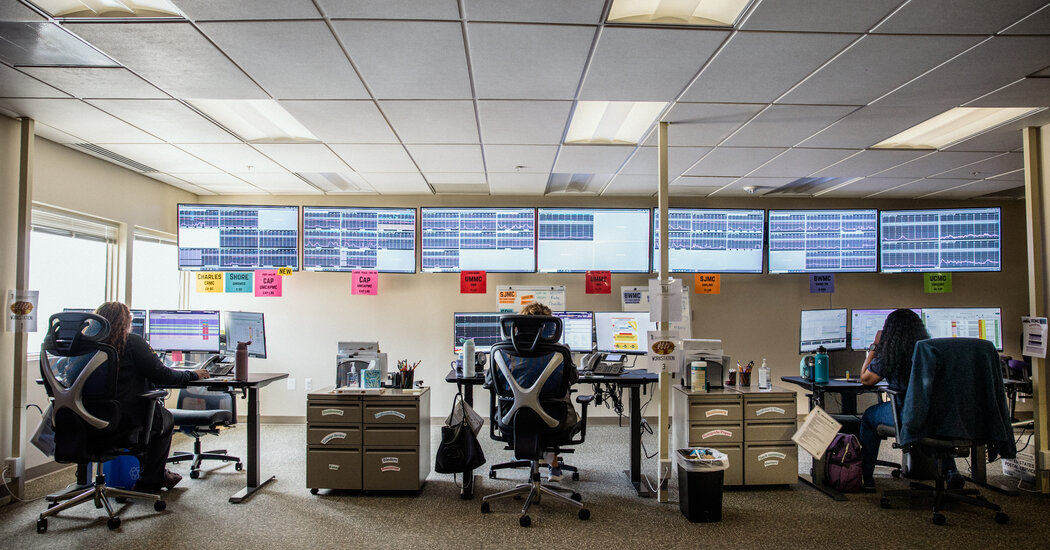Copyright The New York Times

Nearly every woman who gives birth in an American hospital is strapped with a belt of sensors to track the baby’s heartbeat. If the pattern is deemed abnormal — too slow, for example — doctors often call for an emergency C-section. But this round-the-clock monitoring, the most common obstetric procedure in the country, rarely helps baby or mother. Decades of research have shown that the tool does not reliably predict fetal distress. In fact, experts say, it leads to many unnecessary surgeries as doctors overreact to its ever-changing readouts. The obstetrics field has long ignored these problems. Now, it’s putting more trust than ever on the flawed technology, often prioritizing business and legal concerns ahead of what’s best for patients, The New York Times found. This fall, the American College of Obstetricians and Gynecologists updated its guidelines on continuous monitoring, sanctioning it even as some other wealthy countries have cautioned against its routine use. Some large hospitals have opened remote monitoring hubs, where nurses spend their shifts watching screens of pulsing squiggles beamed in from many miles away. Software companies have also jumped at the opportunity, selling unproven artificial intelligence algorithms that claim to pluck useful signals from the heartbeat noise. All the while, the rate of cesarean sections in the United States remains stubbornly high. One out of every three deliveries happens in an operating room, a figure that far exceeds public health recommendations. The surgery can prolong a woman’s recovery, complicate future births and sometimes risk her life. The top justification for C-sections in healthy pregnancies is fetal distress, a diagnosis made by the monitor. “We may be the only specialty that continues to do major abdominal surgery without a shred of evidence of benefit,” said Dr. Steven L. Clark, an obstetrician at Baylor University in Texas who has extensively studied electronic monitoring. “We just plow blithely on.” When electronic monitoring replaced simple stethoscope checks in the 1970s, doctors embraced it as a seemingly objective marker of how a birth was progressing. From the start, device companies pitched hospitals on an economic advantage: The tool allowed a single nurse to observe many patients at once. On rare occasions, the fetal heartbeat can reveal when something has gone wrong. The trouble is, healthy babies have highly variable heart patterns. Since the introduction of continuous monitoring, doctors now have many more opportunities to mistakenly interpret these ambiguous signals as telltale signs of distress. “Mostly it causes harm,” said Dr. Emmet Hirsch, an obstetrics professor at the University of Chicago Pritzker School of Medicine who has critiqued the approach in a leading medical journal. “It’s really the worst test in medicine.” Other experts echoed his blunt assessment, with some calling the technology “useless” and “pathetic.” Electronic monitoring is no more accurate than periodic stethoscope checks, studies have shown. But many obstetricians practicing today have never worked without a monitor. Some said they were convinced that the tool helped them practice better medicine, even if studies hadn’t shown it. Others felt that, with monitoring baked into hospital policies, the question of how patients might fare without it was moot. “It’s just easier to keep patients hooked up continuously,” said Dr. Jon K. Hathaway, an obstetrician at Indiana University Health. “It’s an ease-of-manpower issue over the science.” The technology has become pervasive in the courtroom, too. Several states have set recent records for malpractice verdicts with cases hinging on fetal monitoring. Highly paid expert witnesses point to the heart patterns in order to claim that a doctor missed warning signs of birth injuries like cerebral palsy, while defense witnesses use them to argue that nothing went amiss. The technology’s promise has long exceeded its capabilities. Dr. Edward H. Hon, an obstetrician at Yale, began studying fetal heart patterns in the 1950s, trying to find markers of oxygen deprivation. In one case report of an infant born too premature to survive, he claimed to have found a distinctively slow heartbeat many hours before death. The Epsco Medical company soon debuted the “Hon Fetal Monitor,” a tall box that spit out heart patterns on long strips of paper. In the early 1960s, the machine cost $9,950, or more than $100,000 in today’s dollars. Advertisements in medical journals at the time said the monitor gave the “earliest possible warning” of heart deviations. “Hopefully, Dr. Hon’s new system could save as many as 20,000 babies a year,” Life magazine wrote in 1969. But when Dr. Hon published data on his device the next year, he sounded a cautious note. His study found that 252 high-risk patients at Yale had modestly positive birth outcomes when using the monitor but noted that a “sizable, carefully controlled study” was still needed to prove its effectiveness. Early critics warned that any screen looking for events as rare as death and brain injury was doomed to pick up false positives. Nevertheless, doctors adopted electronic monitoring with fervor. “The thought was, ‘What could be the downside of this?’” said Jacqueline Wolf, a medical historian at Ohio State University. Manufacturers trumpeted how their monitors could stand in for hospital staff, according to dozens of ads archived at the National Library of Medicine in Bethesda, Md. “One person can continuously and simultaneously monitor eight patients,” read an ad in 1970. Another, from 1980, claimed that a monitor was “like keeping a nurse at every bedside.” The technology’s uptake coincided with a drop in stillbirth rates, and some hospitals published studies attributing the improvement to electronic monitors. But a clinical trial that randomly assigned women to the device, published in 1976, found no improvement in the number of newborn deaths or other negative outcomes. A government report concluded that other changes, like the advent of neonatology as a specialty, better nutrition and fewer young women giving birth, probably drove the stillbirth decline. That first trial, as well as a large follow-up, also reported a significant harm of the technology: a far higher rate of C-sections. Surgery Risks And the technology increased a woman’s odds of cesarean delivery by 63 percent, the review found. Cesarean rates in the United States began to soar in the 1970s and have exceeded public health targets for years. The surgeries come with a host of medical risks to the mother, including hemorrhage and infection. The primary justification for C-sections among women with healthy pregnancies is “fetal distress,” a diagnosis nearly always based on the monitor, according to a recent study of 40 million births. “Electronic fetal monitoring, as a single entity, has probably driven up the C-section rate more than anything else,” said Dr. George A. Macones, who directs women’s health at Dell Medical School in Texas and has long studied monitoring. “Seeing the heart rate dropping on the monitor, it made me sick to my stomach,” said Ms. Hankerson-Pinkney, 37, a lawyer in Lauderdale Lakes, Fla. When she got pregnant again the next year, her placenta grew into the scar tissue left on her uterus from the surgery — a life-threatening condition that, while rare, has become more prevalent as C-sections have risen. Because the two organs were entwined, natural labor could have killed Ms. Hankerson-Pinkney. So she delivered five weeks early, and the infant was put on a breathing machine. When doctors could not wrest the placenta out of Ms. Hankerson-Pinkney, they removed the entire fused uterus, dashing her hopes of more children. “It was more traumatic than I would like to express,” she said. “Each delivery involves unique clinical factors, including the mother’s age, body mass index, any pre-existing conditions and potential distress of the baby indicated by the fetal heart tones,” the company said in a statement. The obstetrician overseeing that surgery, Dr. Jay S. Cohen, had a 63 percent cesarean rate in 2023, about double the national average, according to the most recent data available from Florida’s Health Department. Dr. Cohen said his practice attracted a “very high-risk population” that other doctors turn away. As for Ms. Hankerson-Pinkney, he said, “I think she was very happy with the care she got.” Record-Breaking Lawsuits Obstetricians are more likely to get sued than doctors in any other medical specialty. Monitoring records often become critical evidence, with expert witnesses on each side offering competing interpretations. “It’s very squishy,” said Amy Collignon Gunn, a partner at Gunn Slater in St. Louis. “You get a lot of subjective reading.” In July, Ms. Gunn represented a Missouri family who won $48 million — the state’s largest malpractice verdict in decades — after using monitoring records to claim that a hospital was responsible for a baby’s cerebral palsy. In a similar case that month, a Pennsylvania court ordered a hospital to pay $207 million. A Utah judge went even higher in August, awarding $950 million to the family of a brain-injured baby. No studies have shown that performing a cesarean based on fetal heart patterns can prevent cerebral palsy. Yet expert witnesses often point to monitor readings to claim a doctor was negligent. Dr. Michael Cardwell, a retired obstetrician in Columbia, Mo., said he had consulted on more than 600 cases in his 40-year career, almost always testifying against doctors. He charges $700 an hour to review documents, and $12,000 to $15,000 for a day of trial testimony. At least two courts, in Arizona and Maryland, have rejected his opinions about fetal monitoring in recent years because he did not provide research to back up his claims. Dr. Cardwell said he did not know that his testimony in those cases had been excluded, and that it rarely happened. Sometimes, he said, courts “try to use evidence-based medicine to an extreme point of view.” Dr. Cardwell was the family’s expert witness in the record-breaking Pennsylvania case, which an appeals court upheld in July. He and a defense witness offered wholly different interpretations of the same monitoring strip. He told the jury that the baby would not have been injured if doctors had delivered him around 1:30 p.m. instead of 2:30 p.m. “What is the baby telling us here?” the family’s lawyer asked Dr. Cardwell, referring to a spot in the readout before 2:30 p.m. “The baby is telling you, ‘I’m not getting enough oxygen,’” the doctor responded. The defense’s witness, Dr. Laura Goetzl, an obstetrician at the University of Texas, testified that the records did not indicate an emergency. She said the baby’s brain injury was probably the result of inflammation from a uterine infection that both sides agreed had occurred. An umbilical cord test, she said, had found a normal fetal oxygen level. In a brick office building outside Baltimore, nurses with the University of Maryland Medical System sit day and night watching screens of fetal heart data from seven hospitals as far as 60 miles away. “With cutting-edge A.I. technology, we are setting the highest benchmarks for safety and equity,” a news release boasted after the monitoring hub opened last year. A growing number of hospitals have opened such facilities, often making claims about patient safety. The Ochsner Health system in Louisiana has said that its remote hub reduced admissions to neonatal intensive care. But a 2021 study by Ochsner’s own researchers found that was not true. (The study did find a slight drop in C-sections, though statewide rates were also declining during the same period.) An Ochsner spokeswoman said the claims about improved NICU admissions were based on “internal data.” The hubs have also helped lower costs, hospital executives told The Times. At OhioHealth, which opened the country’s first remote monitoring facility in 2013, the extra layer of expertise has made administrators more comfortable hiring nurses with less experience on labor and delivery floors, said Dr. Jason V. Melillo, the hospital’s vice president for women’s health. That change has been particularly helpful, he said, given the nursing shortage. At the same time, OhioHealth’s leaders believe the hub has helped cut malpractice costs. They estimated saving $13.5 million in its first two years, based on how often nurses intervened in cases that executives predicted would have otherwise resulted in a lawsuit. The facility also helps with optics in legal disputes because it suggests that a hospital took every effort to prevent harm, said Bobbie Sprader, a lawyer who has worked with OhioHealth. “It just looks good, and that sometimes matters more than about anything,” she said in an August webinar for executives. All three remote hubs, along with 400 other hospitals around the country, use A.I. software to help analyze the heart data. The software’s maker, PeriGen, has claimed on its website that 50 studies backed up its products. But none of the studies found that the technology improved birth outcomes. One described how to suture a cesarean scar. PeriGen removed the list of studies after an inquiry from The Times. The company’s chief executive, Matthew Sappern, acknowledged that no clinical trials had shown benefits. “It certainly is not our intent to be misleading,” he said. In its newly updated guidelines, the American College of Obstetricians and Gynecologists said A.I. software for fetal monitoring was unproven. But the organization — which has over 60,000 members and enormous influence over how they practice — supported continuous monitoring, even while acknowledging that evidence for the tool was “inadequate.” Obstetric guidelines in Canada and Britain, in contrast, have recommended against routine use of the tool in healthy pregnancies. When asked why the American guidelines approved of electronic monitoring despite the lack of evidence, Dr. Aaron B. Caughey, an obstetrician who co-wrote the guidelines, said that the research wasn’t perfect and clinical experience also mattered. When he learned in medical school about the technology’s bad track record, he was horrified, he said. But over 30 years in practice, he has found the tool helpful. He hangs his hat on the older studies that showed a benefit. Those that have not, he said, might have simply been too small to prove it. “The practice of obstetrics is hard in 2025,” he said. “But I think that this tool continues to be of use.” Bianca Pallaro contributed reporting. Alain Delaquérière and Sheelagh McNeill contributed research.



